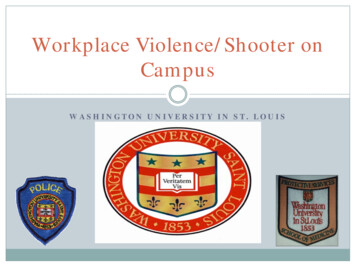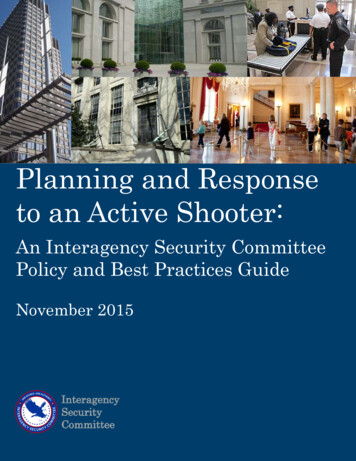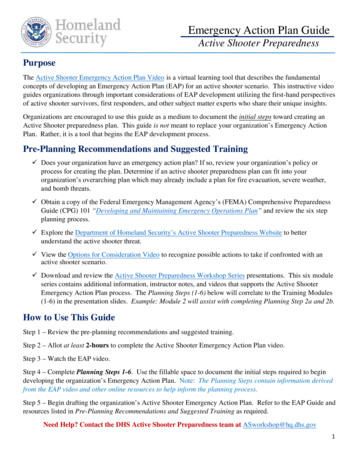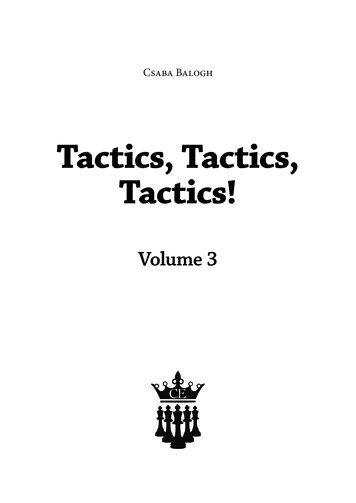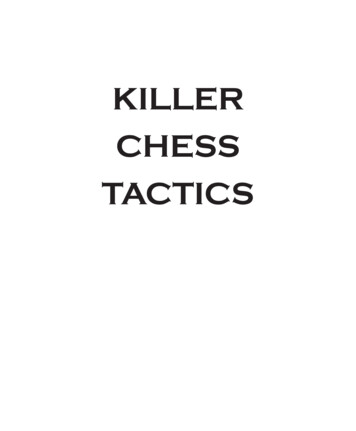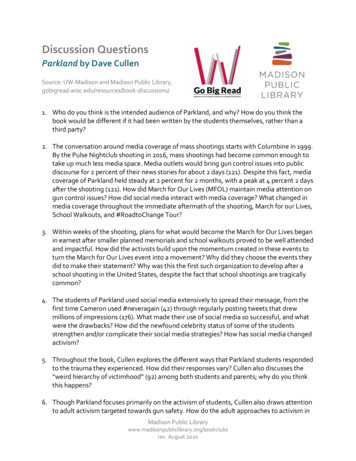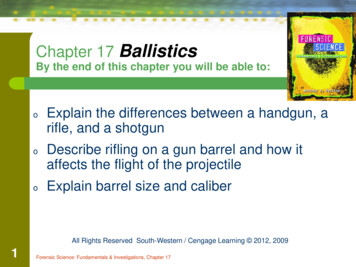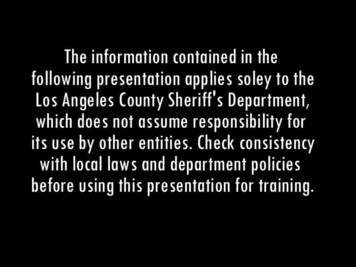
Transcription
Active ShooterResponse & TacticsBy Deputy John WilliamsLos Angeles County Sheriff’s Department
“It’ll be like the LA Riots, the Oklahoma Bombing, WWII, Vietnam,Duke and Doom all mixed together I want to leave a lastingimpression on the world if by some weird as shit luck me and Vsurvive then we will hijack a hell of a lot of bombs and crash aplane into NYC.”Excerpts from Eric Harris DiaryColumbine HS Gunman
This presentation deals with how to prevent,prepare, and tactically respond to a activeshooter incident. This will include a historicaloverview of noteworthy active shooter incidents,with an emphasis on school shootings.Lessons learned, key terms, and importantdefinitions will be discussed as well as the crisisresponse box, lockdown, and evacuationprocedures. This presentation will also review lawenforcement equipment, training and tactics aswell as post shooting event incident managementand threat assessment & managementtechniques.
DefinitionsActive Shooter: A suspect who’s activity is immediately causing death and serious bodily injury. The activity is notcontained and there is immediate risk of death and serious injury to potential victims.Barricaded Suspect: A suspect who’s in a position of advantage, usually barricaded in a room or a building and isarmed and has displayed violence. May or may not be holding hostages and there is no indication that the subject’sactivity is immediately causing death or serious bodily injury.Traditional Deployment: A tactical concept where Officers maintain a secure perimeter around a life threatening armedsuspect situation and wait until specially trained units (S.E.B., S.W.A.T., etc.) arrive at the scene to finally intervene.Rapid Deployment: The swift and immediate deployment of law enforcement personnel to on-going, life threateningsituations where delayed deployment could otherwise result in death or great bodily injury to innocent persons.Dynamic Situation: The situation is evolving very rapidly along with the suspect’s action. Example: The shooter ismoving and shooting.Static Situation: The situation is not evolving or in motion. The suspect appears to be contained. Example: Thesuspect is barricaded in a room.
The ACTIVE SHOOTERCommonalities& Lessons Learned Active shooter incidents are often spontaneousSuspects behavior was unpredictablePre-incident signs existed in school incidentsIncidents occur in a target rich environmentA tactical intervention was too lateMulti-jurisdictional response issues were presentIncidents occurred in a “target rich” environmentSuspects usually do not have a escape plan9 out of 10 active shooters are suicidalAverage age for a school shooter is 14.5 years oldSuspects are mentally deranged or acting in a diminished mental capacityMass murder is most often the goal rather than other criminal conduct, such as robberyMost active shooter incidents are over within 10 minutes or lessMultiple weapons and ammunition are often involvedFirst responders often are outgunned and ill-equippedPolice officers often did not have proper trainingExpect carnage and complete chaos, noise, confusion, alarms with frightened people runningand hiding and unwilling to respond to your directionsA “traditional” police contain and negotiate tactic does not work tactical intervention isneeded
The ACTIVE SHOOTERTraditional Deployment to an Active Shooter EventUpon Patrol Deputies arrival at the scene Secure the Perimeter. Gather Information/Help Victims. Wait for S.E.B. to arrive.Unfortunately in situations such as Columbine this precedent failed.Rapid Deployment to an Active Shooter EventNew Tactic used by Law Enforcement. Upon Patrol Officers arrival at the scene Enter the area / building as fast as possible. Sole objective is to Neutralize the hostile threat with the least amount of forcepossible. Turn scene over to Special Weapons Team when they arrive.Be advised: Immediate deployment tactics are not asubstitute for conventional response to barricadedsuspects.
The ACTIVE SHOOTERActive Shooter / Barricaded Suspect Intervention ConceptsThe Mission Objective is to bring about the successful resolution of any critical incident situationwith the intent and purpose to minimize the risk of injury or loss of life to Citizens, Deputies andSuspects, by utilizing the personnel, training, equipment and assets available or obtainable. There is no foolproof way to do this.You, potential victims and your fellow Officers are not considered expendable in any way.An Emergency Rescue (if necessary) and the building search that would follow are some of themost lethal activities a Officer will perform.The terrorists or suspects have a considerable advantage over the entering team and if they aredetermined, will in all probability, at least injure one or more of the team members or hostages /victims.Officers realize and accept the dangers, they also realize if they do nothing, more peoplewill die or be injured then if they had taken action.When should Rapid Deployment be Utilized? Answer: Aggressive Deadly Behavior – The suspect is armed andactively engaged in causing death or serious physical injury and thelocation is believed to contain multiple victims. i.e. Schools,Playgrounds, Daycare, etc. A delay in using Rapid Deployment tacticscould result in continued injury to citizens & children. Delayed recoveryof victim(s) and could result in the victim(s) demise.
The ACTIVE SHOOTERRapid Deployment Tactics As a first responder, you need to asses the situation.Request appropriate resources, such as additional Patrol Units, Urban Police Rifle (AR-15),Fire Department, Medical Personnel, Air Support, and S.E.B.Obtain best possible field of view of location.Obtain as much information as possible from witnesses.Communicate with location employees and/or school staff.Collect and communicate assessment of situation clearly and concisely.Next, you need to determine if Rapid Deployment Tactics are necessary?Is the situation Dynamic or Static? If so, advise responding units of the situation.Coordinate response of assisting units.Quickly assemble the appropriate teams (Both a Contact and a Rescue Team if resourcesallow) and deploy as soon as possible.Move to the Shooter.Apply Necessary Force.Rescue and Evaluate.Transition to Special Enforcement Bureau when they arrive to the scene.The one consistent theme throughout Rapid Deployment (Active Shooter) situations is thatcircumstances will dictate our response. It is not a perfect science – Too many variables.- Whether entering the building with two Deputies or waiting for a third or fourth.- Whether stopping to pat down “injured victims” or moving past them.- Deputies must be able to articulate/justify their actions.
The ACTIVE SHOOTERRapid Deployment Priorities The capture or neutralization of the suspectThe lives of those in proximity of the shooter and the safety of fellow officers and citizens in the area.Containment (Inner & Outer perimeter)First Responders must: Immediately respond and coordinate a plan using non-traditional methodsAnticipate the first responders to be patrol deputiesThe initial response will be limited to those officers in the field. Resources will be at a minimum.These officers may or may not be trained and equipped for this type of incident.Priority must go to saving lives rather than containing the location.The officers must be ready to contain and transition to a barricade situation if necessary.
First Responder TacticsContact Team:If Rapid Deployment is necessary, create a “Contact Team” out of a minimum of four Deputies. The mission is to stop gunman/attacker.You must move expeditiously to sound of gunfire.If shooting stops, the contact team should slow down and precede cautiously forward to locategunman.You may bypass victims if suspect is actively shooting others.You should note location of victims and notify others to perform rescue. Rescue Team:This is the secondary team made up of the subsequent arriving officers. Primary mission is to locate, remove or escort victims from danger.Team may encounter suspect and assume Contact Team mission.Good communication with Contact Team a must.Be aware of Friendly Fire situations.Determine location of victims.CAUTION: The movement required for Rapid Deployment breaks many of the tactical andsafety protocols that a Deputy would utilize when conducting a building search in a hostileenvironment. This is done so that the teams involved can move as quickly as possible to theirobjectives. The Deputies involved will have to weigh the risks for themselves. The slowerthey respond, the higher the probability of injury and loss of life to more innocent victims.
First Responder TacticsWhat to expect upon entry:The dynamic environment of an active shooterscenario will bring with it a host of problems.These problems may include, but are notlimited to, the following: Noise from alarms, people screaming, etc.(affecting communications) Confusion. Victims hiding and frightened-notresponding to law enforcement directions. Carnage and multiple, traumatic injuries. Fire suppression systems and sprinklersystems. Explosive devices, if encountered: Visually inspect device for potential detonation(timing device, trip wire, lit fuse, etc).Identify and, if possible, verbally reportlocation(s) of device(s)DO NOT move or touch them.Move past device when part of aContact/Rescue team.Would you know that this is a undercover copresponding to the incident?
First Responder TacticsTeam Formations Utilize basic Diamond Formation (4-Man) or similar variation.Team Leader-Right Flank-Left Flank-Rear CoverDepending on structure team positions may change.If available, additional bodies may be added to flanks or point.If multiple victims are present, consider adding members to Rescue Team.Basic 4-Man DiamondAllows for 360 degree security/coverage.360 degree Coveragewith RedundancyConcept: Overlapping Areas of Responsibility
First Responder TacticsBasic 4-Man DiamondDirection of MovementContact ManTeam Leader / Cover OfficerCover OfficerCover Officer / Rear Guard
HallwaySettingForwardMovementContact Officer1L23
If somethinghappens and theteam has toreverse directionthen positionsare switched(Not donephysically).Contact Officer1L23ForwardEach Officermust know theresponsibilitiesof each positionin the team.
This parameter however is notetched in stone. There are certainunique situations where flexibility ofthe formation is allowed and shouldbe utilized.
If Contact is madeProvided rearcoverage is secure,it is better to have4 weapons downrange then 3.And theContact Teamis fired upon.1L23
First Responder TacticsT – FormationUsed to pass hallways & doors.
Moving Down a Hallway
Try to Avoid Hugging Walls in theBullets do not Ricochet as we Think!HallwaysL312Correct
Bullets do not Ricochet as we Think!L312Incorrect
Moving to a “Stack Formation”through a Small OpeningL3LL2211L3 31 122
“Slicing the Pie”Angles create amajor issue whennavigatingHallways!
Moving down a Hallway; T-intersection“Point Method”
Moving down a Hallway; T-intersection“Wrap method”
Moving throughan Intersection
Be Careful when usingCorners as Cover!
Moving down a Hallway - Clearing a RoomL33 1311LL2L22 21
#2 ManhasslicedtheUnknown!Pie?1st Officerin goesintoFirst?theWhoGoes31L2?
Room Clearing: Button Hook Method31L2?GO123
Room Clearing: Criss-Cross Method31L2?GO123
Criss Cross MethodNote that bothOfficers go intothru the doorsimultaneously, onehigh and one low.
ConsiderationsLosing contact with the suspect .Suspect contact and apprehension.Evacuations.Use of deadly force.What to expect on entry.Encountering explosive devices.
Losing ContactWhat to do when the shots and thescreaming stops during your entry?-Has the suspect committed suicide?-Has he taken a hostage and barricadedhimself?-Has he escaped?Have a Plan!
Suspect Contact andApprehensionPrimary Goal:-Stop suspects deadly behavior.-Take suspect into custody.Remain in a position of cover, bring thesuspect to you.Give clear and concise orders to thesuspect.
Keep in Mind!If a Suspect isbeingapprehended bya Team1His Coverarea ofMancoveragejustThe(RearhasGuard)L t hand!assignment!3
First Responder TacticsRescue FormationUsed to evacuate casualtiesThe Rescue Team should be prepared to provide cover,escort, and direct victims to evacuate under there own power ifat all possible. If the victim cannot self evacuate and suffers ofeminent life threatening injuries, the team can utilized twoDeputies to carry the victim to safety. Of course, it isunderstood this dramatically reduces the coverage andresponse of the team if they encounter the shooter(s).
Evacuating a VictimL312
Evacuating a VictimL312
Evacuating a VictimL312
First Responder TacticsBreaching Shotgun Must have 3” muzzle standoff or risk barrel explosion.Barrel is pointed downward and at a 45 degree angle to lock.Special ammo designed exclusively for breaching should be used, althoughstandard ammo can be used in an extreme emergency.Must communicate prior to breaching to avoid misidentification by otherresponders who hear shot(s).BREACHING SHOTGUN –Use with caution and only in extremeemergencies. It is lethal to someonestanding behind a breached door.
Proper Equipment and WeaponsAs evident by the Bank of America shoot out in North Hollywood in 1997, Patrol Officers werecompletely out-gunned. Active Shooters will often have higher powered weaponry and longrange rifles. Responding officers should at a minimum be equally equipped. A well equippedresponding officer should have a rifle (AR-15, Mini-14, etc.) or shotgun with slug rounds. Theadvantage of a rifle over a handgun is that they are more accurate over greater distances, candefeat body armor, and usually have a higher magazine capacity.Breaching Equipment Includes:- Mechanical Breaching Tools such as a sledge hammer, ram, shotgun or halligan toolBreeching Tools - versatile but cumbersomeRamHalligan toolBreaching Shotgun
Proper Equipment and WeaponsShields: Ballistic Shields offer some protection, but are bulky,cumbersome and ineffective against most rifle rounds. Consider using vehicles as a shield for approach(Fire trucks, Radio Car)Additional Equipment Considerations: Ballistic HelmetsBallistic Vests- Train to use hand & arm signals for communication.Slings on shotgunsProtective GlovesRadio ear speaker- High noise level probable- Massive volume of radio traffic
The Post Shooting EventIncident Management (SEMS)The Standardized Emergency Management System (SEMS) is a nationally recognizedemergency operations plan that is adapted for large critical incidents where multi-agencyresponse is required. SEMS facilitates priority-setting, interagency cooperation and theefficient flow of resources and information. SEMS allows law enforcement to respond to anycritical incident with better communication and coordination with other responding agenciesand organizations.Incident Command Post:Needs to be located in a secure area out of sight & hearing ofthe incident with staging areas located nearby.Staging Areas:--Tactical Staging Area: Police/SWAT CoordinationLanding Zone: Police/Fire/Medical HelicoptersFire Department Staging AreaTriage / Medical Staging AreaNews Media Staging AreaInterview Area – Witness Identification & Interview area.Evacuation Site / Relocation Site: Acts as parent and studentreunification and release area.- Psychological servicesshould be offered at this area if available along with anyschool resources, announcements, and student/victiminformation.
Communications Issues Cellular Telephone use may overwhelm the local cell site and may result in intermittent orbroken communications. The local phone company may be able to bring in a portable cell siteif requested. Hard Telephone Lines are usually more reliable, but not as convenient. The local phonecompany may be able to drop hard lines from a nearby pole upon request. 2-Way Radios. Be advised that the suspect(s) may be able to monitor your communicationthru the use of a portable scanner.Media Issues: Make sure you give a coordinated media release with all on-scene agenciesbeing onboard. Speak with one voice and avoid exclusive, unofficial or off-the-recordcomments or remarks.
Local SchoolProcedures
A School and Sheriff Partnership Schoolsand Law Enforcement need to work together and develop realistic school safety plansin response to various threats. They need to conduct joint training sessions and test procedures in a realistic environment. These exercises should be conducted in a realistic environment with maximum sensoryoverload. A Memorandum of Understanding between local law enforcement and the Schools should be inplace to establish procedures to be followed when an incident involving an act of violence takesplace so the School Administration will know the plans and tactics the law enforcement will useto resolve the situation.Should a School evacuate or lockdown in a Active Shooter Incident? Absentexigent circumstances such as a fire in the immediate area, Schools should call 911 andlockdown. This ultimately will result in less targets for the shooter(s), reduce confusion forarriving officers, help contain the situation, and minimize the chance of an accidental shootingby responding officers.Recommended School Lockdown Procedure: Have a Signal/Code. Lock Doors. Establish Safe Area. Account for Students. Do Not Open Door Until Deputies Arrive. Communicate.
Classroom Safety Tips:Once the School is lock down, minusexigent circumstances, no one should leavethere position of safety. Classrooms shouldbe locked and students should beinstructed to stay quiet, get down low, andsit out of view of the windows. A door orwindow placard system can be used to helpidentify your location as being eitheroccupied by non-hostiles (Green Color) orin need of medical treatment (Red Color). Nocolor indicated would result in lawenforcement treating the location as apotential suspect location.Rule of thumb for School Staff: Call 911 and stay on the phone.Meet law enforcement if possible.Isolate and evacuate as soon as possible.Collect as much information as possible.Don’t try to be a hero.Allow police first responders to make contact.No InjuriesInjuries“During a crisis you cannot be guaranteed ofcommunications between a classroom andemergency personnel. Port Huron schools came upwith a novel idea to alert SWAT Team members of aninjured person in a classroom when communicationshave been cut off: In every teacher’s closet, there aretwo sets of three posters, each of a different color. Ina life-threatening emergency, all school personneland students know that they are to tape the red cardin the window to alert people on the outside that theyneed help immediately. A yellow card informsparamedics that there are injuries in the room, butnot life threatening. A blue card notifies them thatthere are no injuries. These cards are also placedunder the classroom door into the hallway to notifythe SWAT team of the same information.”Captain James CarmodyPort Huron City PolicePort Huron, Michigan
Lock Down Procedure forClassroomSSSSSSSSSSSST
After the Teacher secures the door,all the students and the teacher willremain against the hallway wall,away from any intruder(s) line ofsight through a door window.SSSSSSSSST
SSSSSSSSST
School Safety Tips:Crisis Response BoxThe purpose of the Crisis Response Box is to quickly locate and provide relevant information tothe right people so they may begin responding.The Crisis Response Box has one simple goal: school administrators will immediately have theinformation essential for effective management of a major critical incident. A crisis is not the time to collectinformation – it is the time to act upon information. Precious minutes need not be lost gathering life-savingintelligence. Knowing what information to collect ahead of time, how to organize it and how to use it duringa crisis are all addressed through assembling the contents of the box.Crisis Response Box“We found that organizing a box . . . thatcontains crucial information we wouldneed to respond to a critical incidentwas a great way for both the schoolsand the police to think through how theywould work together in an actual crisis.The principal, local police and local firedepartment have the same kit. Everysummer we meet and review thecontents and update them.”Captain Terry RammellLa Habra Police DepartmentLa Habra, California
Crisis Response BoxThe Crisis Response Box contains more than directions to use in the event of an emergency. Thefollowing components make possible a thorough school and community response to a crisis:Aerial Photos of CampusAn aerial perspective of the campus and the surrounding area is very helpful to all agencies involved in acritical incident, including police, fire and paramedic personnel.MapCrisis response planners need to review the traffic patterns and intersections that will be affected in amajor crisis. Through this process, you can identify locations where parents or guardians can retrieve theirchildren after an incident and determine traffic safety issues your school and law enforcement will have toconsider when directing youth to safe areas. Keep as many as 20 copies of the map available, preferablylaminated, for emergency personnel. Establish an emergency traffic plan capable of protecting emergencyresponse routes and accommodating traffic and parking needs for parents, students and the media. Themap should illustrate these planned routes as well as: The streets surrounding the school, Intersectionsnear the school, Vacant lots near the school, and Location of major utilities.Campus LayoutIt is important to maintain current, accurate blueprints, classroom layouts and floor plans of the buildingand grounds, including information about main leads for water, gas, electricity, cable, telephone, alarm andsprinkler systems, hazardous materials location, elevators and entrances. This information is extremelyhelpful, especially during a “shelter-in-place” situation when students are safely locked in a classroom.Information should be available on the layout of the building, including room numbers and whether or notthere is a phone, cable television, e-mail, computers or cell phones in the classroom. On the campuslayout diagram, it is also helpful to highlight areas that could pose a possible threat, e.g., the chemistry lab,biology lab or any welding and wood shop areas that could also become a haven for weapons. It is alsohelpful to show the location of the fire alarm turn-off, sprinkler system turn-off, utility shut-off valves, cabletelevision shut-off and first aid supply boxes. These items can be color-coded on the campus layout.
Crisis Response BoxBlueprint of School BuildingsArchitectural blueprints of the school building(s) are important to aSWAT team, and provide additional – and more detailedinformation – than the simple classroom layout diagram. Thisinformation may be critical, especially in the event of a bombthreat. The plant manager for the school site should be thecustodian for the blueprints. Grounds and maintenance staff of theschool should be familiar with these blueprints and their location.Teacher/Employee RosterA teacher/employee roster should go into the Crisis Response Box.If you can enter teachers’ names on the classroom layout diagram,all the better. If not, be sure to match up each teacher’s name withhis or her classroom – and identify whether or not each teacherhas a cell or land phone. This roster should identify anyteacher/employee with special medical needs (e.g., diabetes) whowill require medications during a prolonged period and those with adisability who may require assistance in an evacuation. In a criticalincident, someone in the front office should pick up thevisitor/volunteer/substitute teacher list.KeysThe Crisis Response Box should also contain a master key and an extra set of keys for those rooms forwhich a master key cannot be used. The keys must be clearly tagged. Consider placing the keys in a lockedcontainer within the box to assure added security in case the box should end up in the wrong hands. Someschools have found it advantageous to keep the master key in a Knox box outside of the school. This is asecured metal box that can easily be accessed by a code or a key without having to enter the building. Thiscan prove especially helpful when it is not safe to enter the school. Further information on a Knox box canbe obtained from your local fire department.
Crisis Response BoxFire Alarm Turn-off ProceduresOne of the lessons learned from Columbine was to make it easier to turn off the alarm. The loud alarmmade it very difficult for responders to hear directions. It took considerable time before someone who knewhow to turn it off was able to do so. School officials learned that you can’t assume that the person whoknows how to turn off the alarm will be logistically able to do so. If that person is inside the building he orshe might not be able to get to the shut-off valve; if that person is outside, it is possible that he or she mightnot be able to safely re-enter the school. As a result, a number of people need to know how to shut off thealarm. Providing such information on where shut-off valves are located in the building and the proceduresfor shut-off in the box could prove vital. In addition, though somewhat costly, some schools have installed asecure alarm shut-off system outside the school that can control the fire alarm and sprinklers.Sprinkler System Turn-off ProceduresSprinkler systems may go on during an emergency. During the incident at Columbine, no one was readilyavailable who knew how to immediately turn off the sprinkler system. As a result, hallways quickly filledwith water, making it difficult to escape. In some places, the water reached dangerous levels in proximity tothe electrical outlets – water reaching such outlets could have caused many more injuries and possiblyadditional deaths. At least two people need to be trained and assigned responsibility for turning off thesprinkler system. As backup, the Crisis Response Box needs to provide information on where shut-offvalves are located in the building and the necessary procedures for shut-off.Utility Shut-off ValvesShut-off and access points of all utilities – gas,electric and water – need to be clearly identifiedand their locations listed so they can be quicklyshut off in a crisis. If there is not a fire, the watershould be shut off immediately to preventflooding from the sprinkler system. Unless openelectric or gas lines pose an immediate threat tolife, the decision on whether to shut off theselines should be made by the Incident CommandOfficer.“Open-ended communication with schooladministrators and law enforcement officials must takeplace while planning. Each must know what his or herindividual responsibility is and be comfortable with it. Atragedy is not the place to start debating assignmentsor responsibilities or whose turf it is”.Bill Slade, Chief of PolicePearl Police DepartmentPearl, Mississippi
Crisis Response BoxGas Line and Utility Line LayoutInclude a diagram that shows where gas and other utility lines are located throughout the campus.Cable Television Satellite Feed Shut-offIf your school has a satellite feed for a cable television system, you should also provide directions on howto shut down that feed. Several of the police officers involved in nationally televised shootings recommendthat the cable television feed be shut off so that perpetrators on the inside will not be able to view thewhereabouts of the SWAT team by tuning into live coverage of the scene on the outside. On the otherhand, in a natural disaster, the television system can be helpful (if working) to provide those who aresheltered in- place with up-to-date information.Student PhotosPhotos can help in the essential task of identifying students injured, missing or killed. In addition, in thoseinstances where the perpetrators’ identities are known while the crisis is still in progress, photos can be ofgreat assistance to law enforcement and SWAT teams who must enter the building and make split-seconddecisions amidst a sea of student faces. If you do not have access to copies of student photo IDs, the mostrecent school yearbook will suffice. Be sure to include photos of teachers and staff, as well. You might wantto consider asking vendors who take pictures for your school to digitalize them and make them availableon a CD, which you can then include in the box.Incident Command System (ICS) Key Responders’ Phone NumbersNames and phone numbers for all team participants involved in coordinating with your local emergencyresponse system should be in the box. These people would include the coordinators for the IncidentCommand System (ICS), Public Information, First Aid, Traffic Safety, Student Assembly and Release andGrounds and Maintenance. Also, include the names and phone numbers of other key staff members, suchas the Food, Water and Supplies Coordinator; the bi-lingual translator (if appropriate for your school); andany additional numbers for potential additional positions you have identified. Be sure to place these phonenumbers on several cards so that more than one person can begin calling them.
Crisis Response BoxDesignated Command Post and Staging AreasPolice chiefs involved in several of the recent school shootings recommend that schools and lawenforcement plan for three distinct staging areas, in addition to the Command Post for the IncidentCommand Officer. Among other things, separate staging areas will prevent the press from converging uponparents or parents from c
Mass murder is most often the goal rather than other criminal conduct, such as robbery Most active shooter incidents are over within 10 minutes or less Multiple weapons and ammunition are often involved First responders often are outgunned and ill-equipped Police officers often did not have proper training
